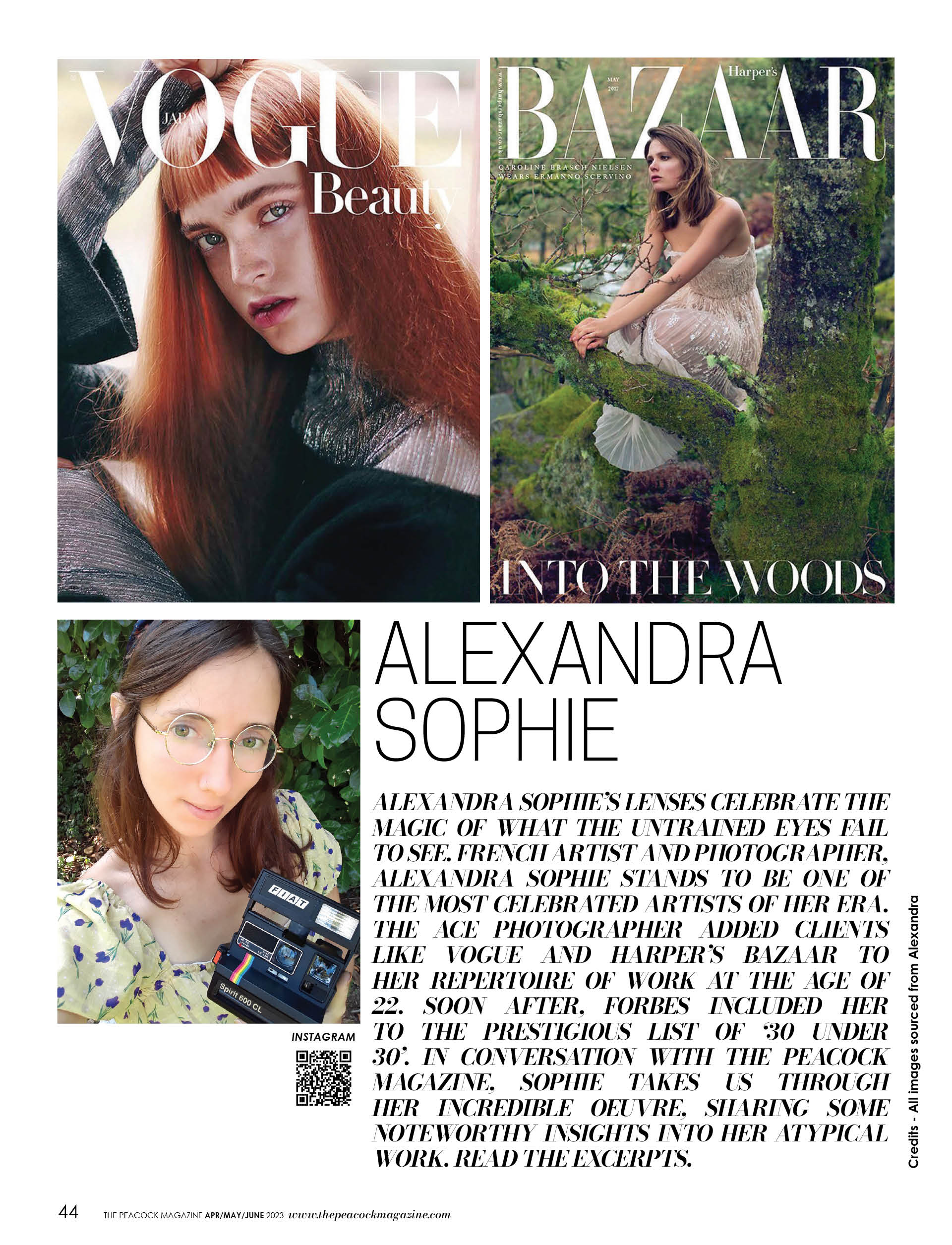
CREDITS: All images sourced from Alexandra
Alexandra Sophie’s lenses celebrate the magic of what the untrained eyes fail to see. French artist and photographer, Alexandra Sophie stands to be one of the most celebrated artists of her era. The ace photographer added clients like Vogue and Harper’s Bazaar to her repertoire of work at the age of 22. Soon after, Forbes included her to the prestigious list of ‘30 under 30’. In conversation with The Peacock Magazine, Sophie takes us through her incredible oeuvre, sharing some noteworthy insights into her atypical work. Read the excerpts.
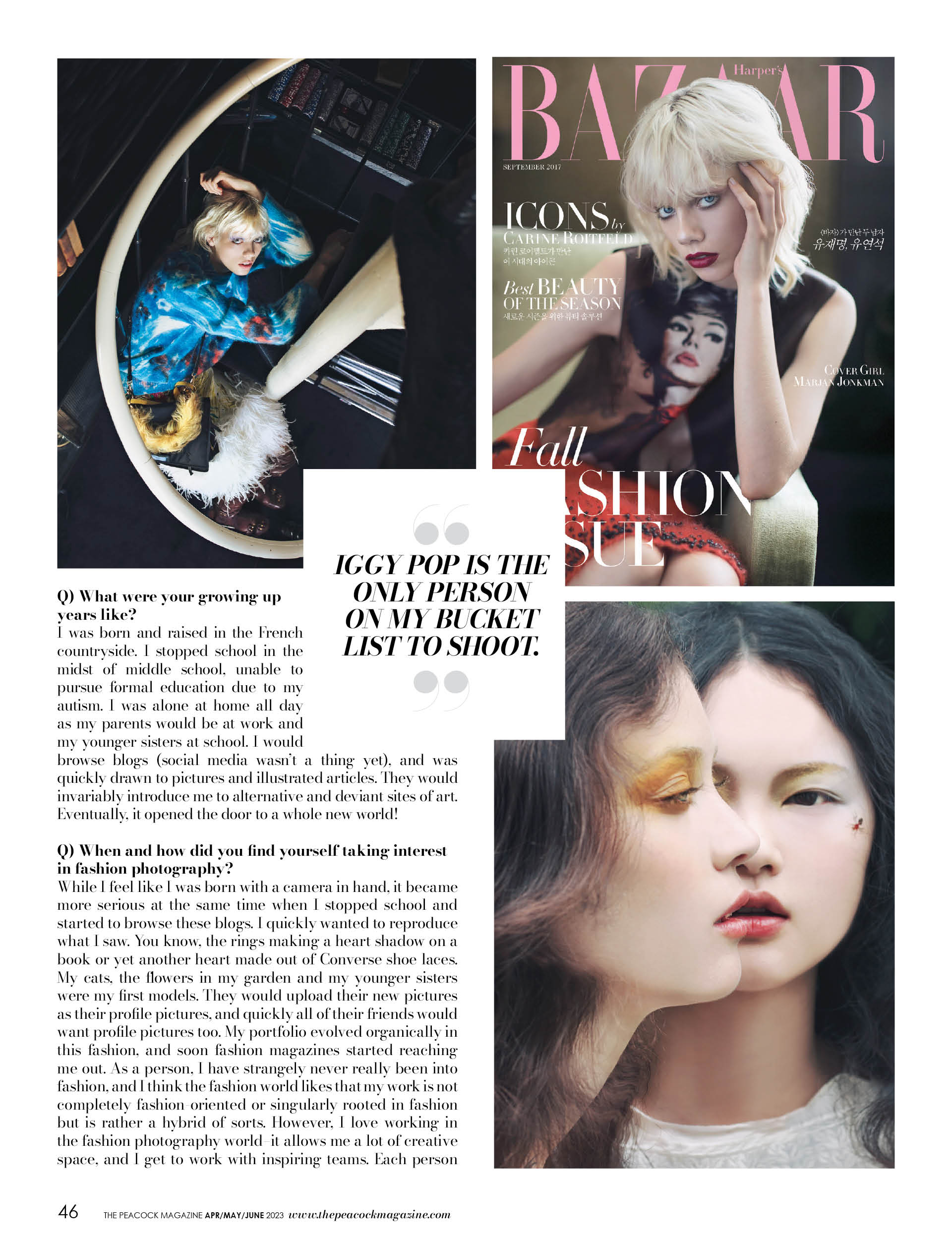
Q) What were your growing up years like?
I was born and raised in the French countryside. I stopped school in the midst of middle school, unable to pursue formal education due to my autism. I was alone at home all day as my parents would be at work and my younger sisters at school. I would browse blogs (social media wasn’t a thing yet), and was quickly drawn to pictures and illustrated articles. They would invariably introduce me to alternative and deviant sites of art. Eventually, it opened the door to a whole new world!
Q) When and how did you find yourself taking interest in fashion photography?
While I feel like I was born with a camera in hand, it became more serious at the same time when I stopped school and started to browse these blogs. I quickly wanted to reproduce what I saw. You know, the rings making a heart shadow on a book or yet another heart made out of Converse shoe laces. My cats, the flowers in my garden and my younger sisters were my first models. They would upload their new pictures as their profile pictures, and quickly all of their friends would want profile pictures too. My portfolio evolved organically in this fashion, and soon fashion magazines started reaching me out. As a person, I have strangely never really been into fashion, and I think the fashion world likes that my work is not completely fashion-oriented or singularly rooted in fashion but is rather a hybrid of sorts. However, I love working in the fashion photography world—it allows me a lot of creative space, and I get to work with inspiring teams. Each person is a master of their own craft: the makeup artists, the stylists and so on.
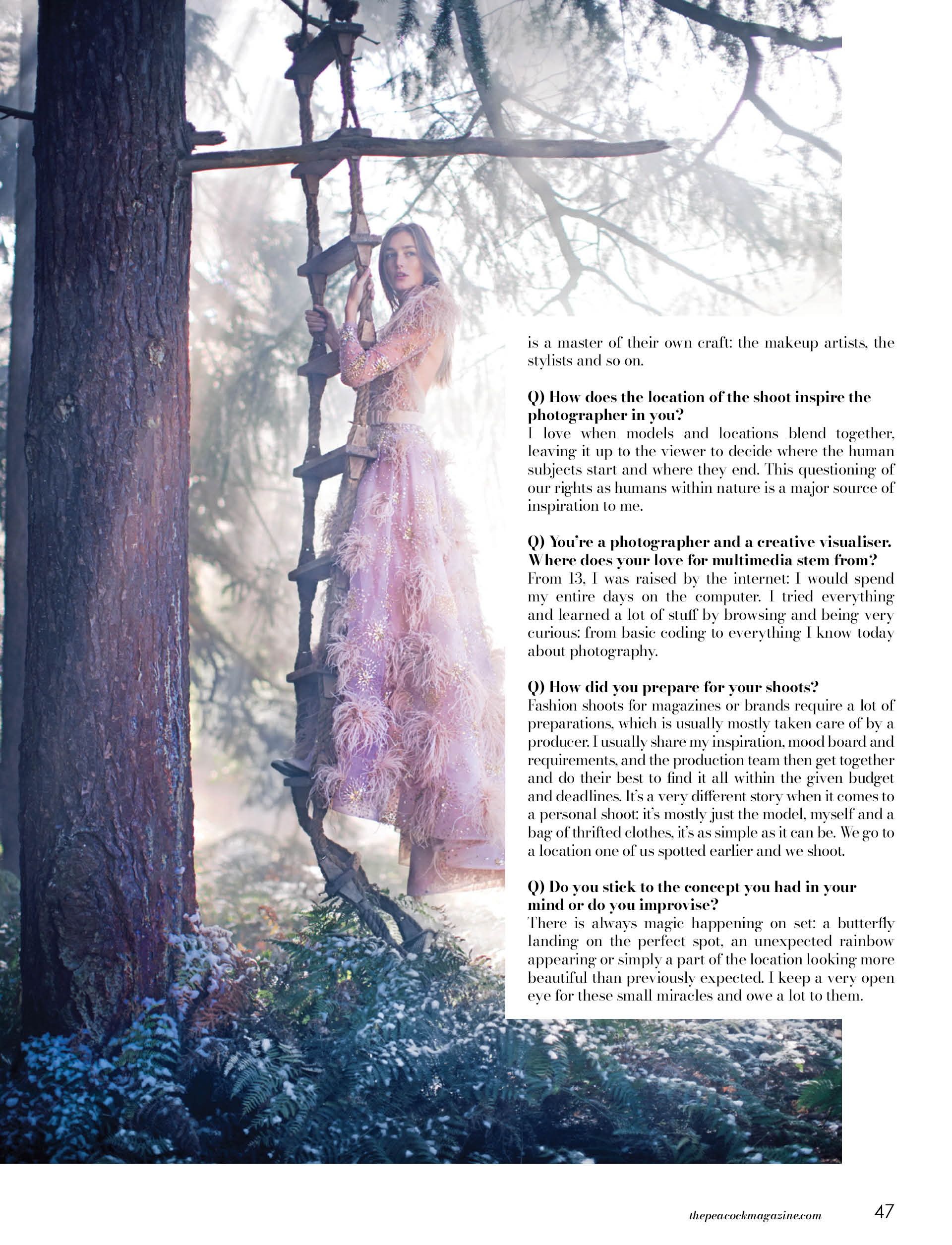
Q) How does the location of the shoot inspire the photographer in you?
I love when models and locations blend together, leaving it up to the viewer to decide where the human subjects start and where they end. This questioning of our rights as humans within nature is a major source of inspiration to me.
Q) You’re a photographer and a creative visualiser. Where does your love for multimedia stem from?
From 13, I was raised by the internet: I would spend my entire days on the computer. I tried everything and learned a lot of stuff by browsing and being very curious: from basic coding to everything I know today about photography.
Q) How did you prepare for your shoots?
Fashion shoots for magazines or brands require a lot of preparations, which is usually mostly taken care of by a producer. I usually share my inspiration, mood board and requirements, and the production team then get together and do their best to find it all within the given budget and deadlines. It’s a very different story when it comes to a personal shoot: it’s mostly just the model, myself and a bag of thrifted clothes, it’s as simple as it can be. We go to a location one of us spotted earlier and we shoot.
Q) Do you stick to the concept you had in your mind or do you improvise?
There is always magic happening on set: a butterfly landing on the perfect spot, an unexpected rainbow appearing or simply a part of the location looking more beautiful than previously expected. I keep a very open eye for these small miracles and owe a lot to them.
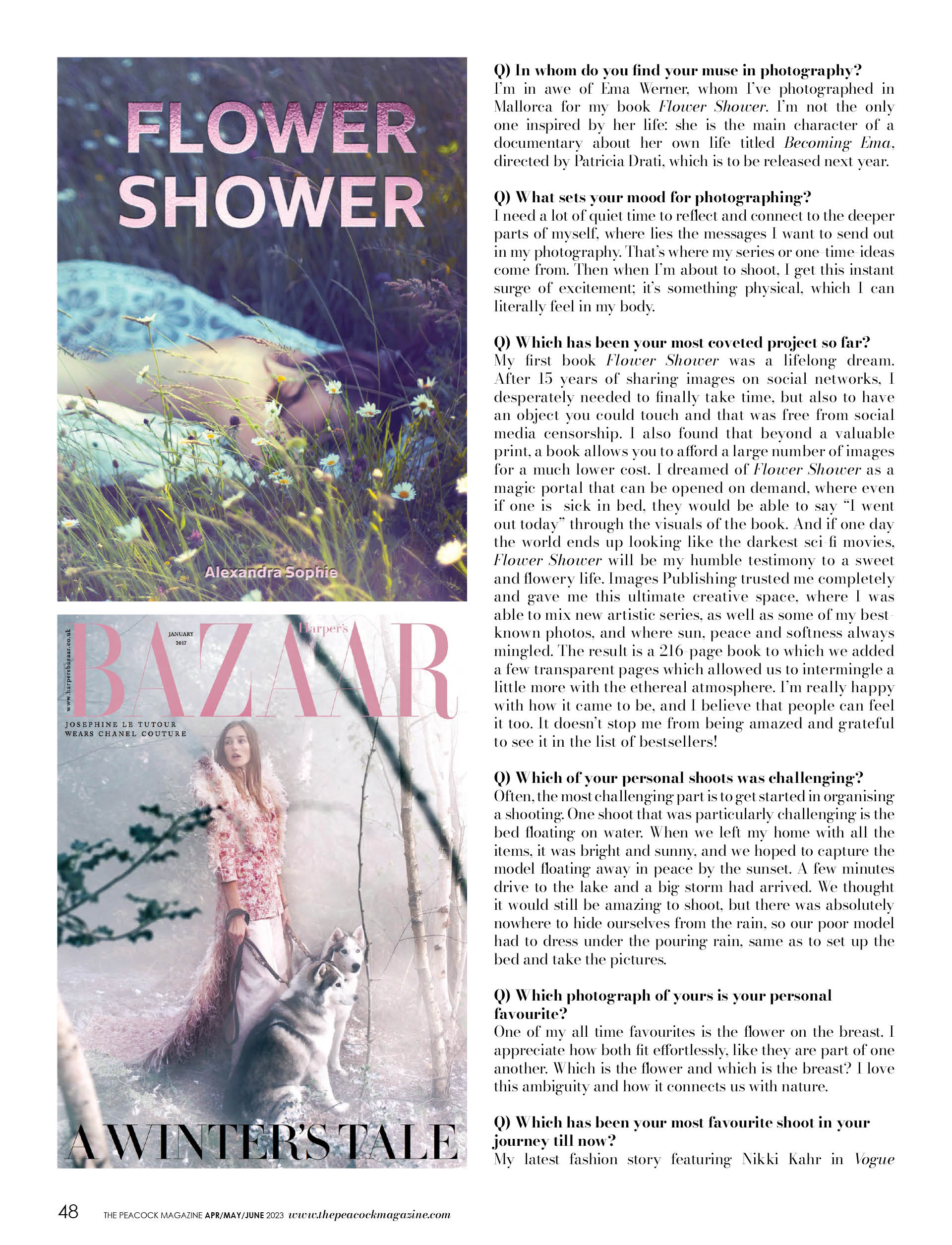
Q) In whom do you find your muse in photography?
I’m in awe of Ema Werner, whom I’ve photographed in Mallorca for my book Flower Shower. I’m not the only one inspired by her life: she is the main character of a documentary about her own life titled Becoming Ema, directed by Patricia Drati, which is to be released next year.
Q) What sets your mood for photographing?
I need a lot of quiet time to reflect and connect to the deeper parts of myself, where lies the messages I want to send out in my photography. That’s where my series or one-time-ideas come from. Then when I’m about to shoot, I get this instant surge of excitement; it’s something physical, which I can literally feel in my body.
Q) Which has been your most coveted project so far?
My first book Flower Shower was a lifelong dream. After 15 years of sharing images on social networks, I desperately needed to finally take time, but also to have an object you could touch and that was free from social media censorship. I also found that beyond a valuable print, a book allows you to afford a large number of images for a much lower cost. I dreamed of Flower Shower as a magic portal that can be opened on demand, where even if one is sick in bed, they would be able to say “I went out today” through the visuals of the book. And if one day the world ends up looking like the darkest sci-fi movies, Flower Shower will be my humble testimony to a sweet and flowery life. Images Publishing trusted me completely and gave me this ultimate creative space, where I was able to mix new artistic series, as well as some of my best-known photos, and where sun, peace and softness always mingled. The result is a 216-page book to which we added a few transparent pages which allowed us to intermingle a little more with the ethereal atmosphere. I’m really happy with how it came to be, and I believe that people can feel it too. It doesn’t stop me from being amazed and grateful to see it in the list of bestsellers!
Q) Which of your personal shoots was challenging?
Often, the most challenging part is to get started in organising a shooting. One shoot that was particularly challenging is the bed floating on water. When we left my home with all the items, it was bright and sunny, and we hoped to capture the model floating away in peace by the sunset. A few minutes drive to the lake and a big storm had arrived. We thought it would still be amazing to shoot, but there was absolutely nowhere to hide ourselves from the rain, so our poor model had to dress under the pouring rain, same as to set up the bed and take the pictures.
Q) Which photograph of yours is your personal favourite?
One of my all time favourites is the flower on the breast. I appreciate how both fit effortlessly, like they are part of one another. Which is the flower and which is the breast? I love this ambiguity and how it connects us with nature.
Q) Which has been your most favourite shoot in your journey till now?
My latest fashion story featuring Nikki Kahr in Vogue Portugal: she is living a normal day with her pet unicorn, including going to McDonald’s and taking a bath.
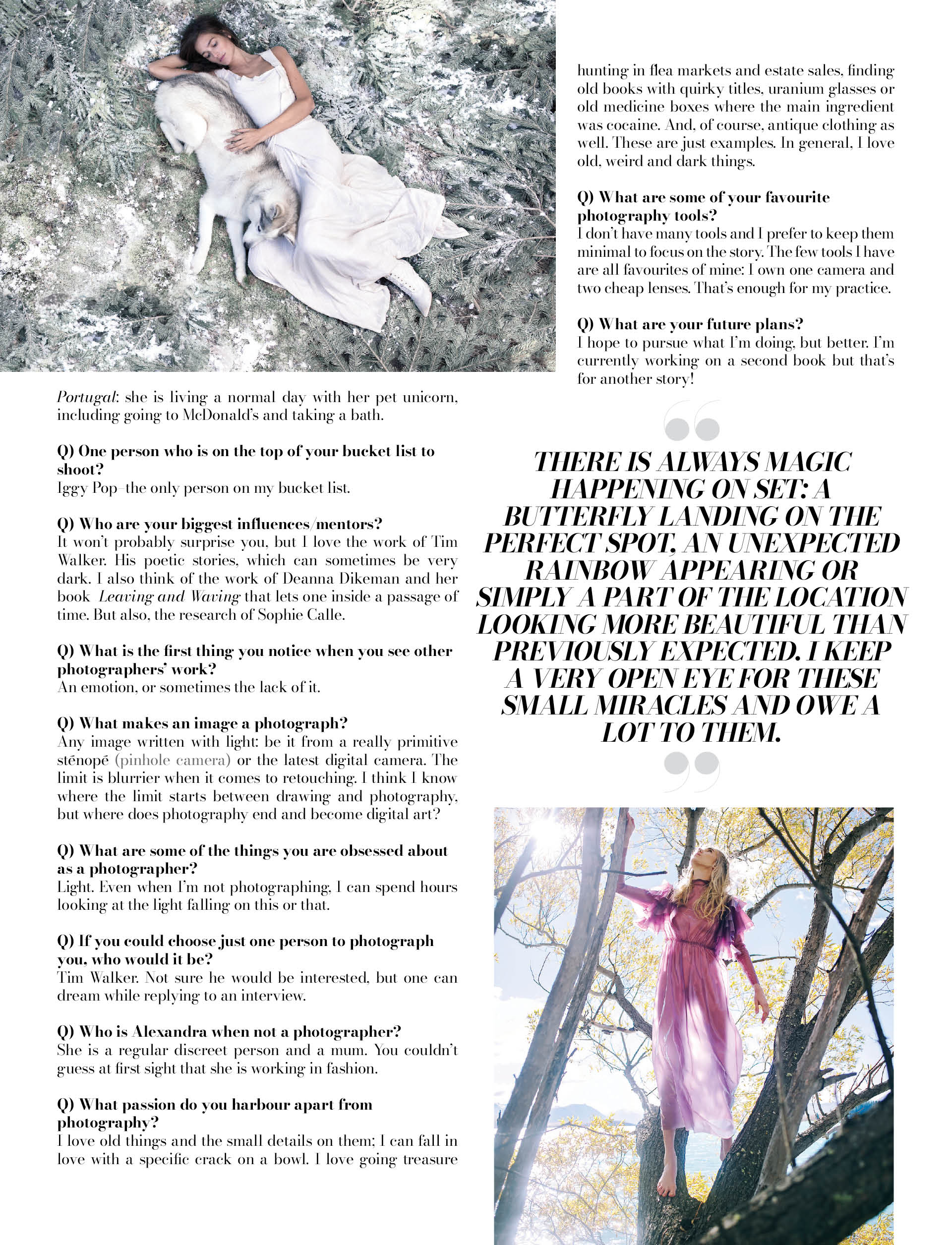
Q) One person who is on the top of your bucket list to shoot?
Iggy Pop—the only person on my bucket list.
Q) Who are your biggest influences/mentors?
It won’t probably surprise you, but I love the work of Tim Walker. His poetic stories, which can sometimes be very dark. I also think of the work of Deanna Dikeman and her book Leaving and Waving that lets one inside a passage of time. But also, the research of Sophie Calle.
Q) What is the first thing you notice when you see other photographers’ work?
An emotion, or sometimes the lack of it.
Q) What makes an image a photograph?
Any image written with light: be it from a really primitive sténopé (pinhole camera) or the latest digital camera. The limit is blurrier when it comes to retouching. I think I know where the limit starts between drawing and photography, but where does photography end and become digital art?
Q) What are some of the things you are obsessed about as a photographer?
Light. Even when I’m not photographing, I can spend hours looking at the light falling on this or that.
Q) If you could choose just one person to photograph you, who would it be?
Tim Walker. Not sure he would be interested, but one can dream while replying to an interview.
Q) Who is Alexandra when not a photographer?
She is a regular discreet person and a mum. You couldn’t guess at first sight that she is working in fashion.
Q) What passion do you harbour apart from photography?
I love old things and the small details on them; I can fall in love with a specific crack on a bowl. I love going treasure hunting in flea markets and estate sales, finding old books with quirky titles, uranium glasses or old medicine boxes where the main ingredient was cocaine. And, of course, antique clothing as well. These are just examples. In general, I love old, weird and dark things.
Q) What are some of your favourite photography tools?
I don’t have many tools and I prefer to keep them minimal to focus on the story. The few tools I have are all favourites of mine: I own one camera and two cheap lenses. That’s enough for my practice.
Q) What are your future plans?
I hope to pursue what I’m doing, but better. I’m currently working on a second book but that’s for another story!?
